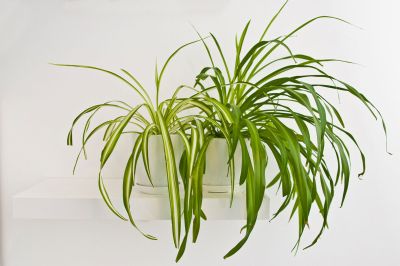Causes of Yellow Leaves on Spider Plants
Spider plants are charming houseplants that are often in the family for generations. The babies they produce will live on for years and produce spiderettes of their own. It is not unusual for many copies of an original spider plant to exist within a family or group due to these spiderettes. If you have the mama spider plant, it can be quite precious since it is the source of so many copies of itself. Yellowing spider plant leaves are, therefore, concerning and the cause needs to be identified and dealt with swiftly.
Environmental issues
One of the more common reasons you may see yellowing spider plant leaves is cultural. The plant doesn’t mind a cramped pot, but you should change the soil annually. If you fertilize monthly, the soil can build up toxic levels of salt. Leach the pot after fertilizing to prevent the salts from burning the roots. These houseplants thrive in many types of light but excess light can cause the leaves to burn and no light will gradually weaken the plant with signs showing up first as leaves turning yellow on the spider plant. Plants can also get yellow leaves if they are moved to a new environment. It is simply a symptom of shock and will clear up once the plant adapts to its new surroundings. Excess minerals in the tap water can also cause discolored leaves. Use rainwater or distilled water when irrigating spider plants.
Disease
A spider plant with yellow leaves may also be suffering a nutritional deficiency, but if you fertilize and change the soil annually, it is more likely a disease. Check to see if the container the plant is in drains freely. Setting the pot on a saucer and keeping the roots wet can cause mold issues and possible root rot. Water your plant when the top half-inch (1.5 cm.) feels dry to the touch. Avoid overwatering but don’t let the plant dry out. Spider plants have few disease issues other than rust and root rot, but root rot can be serious. When you see spider plant leaves turning yellow and are an enthusiastic waterer, remove the plant from its container, rinse the roots, cut away any soft or moldy parts, and repot in a sterile potting medium.
Pests
Indoor plants don’t get many pest issues unless they came from the nursery with bugs or you introduce a new houseplant that has hitchhikers. If you put your plant outside in summer, it will be exposed to many insect pests. Most common are sucking insects whose feeding behavior reduces the sap in the plant and can introduce diseases. Watch for mealybugs, aphids, scale, whiteflies, and mites. Combat these with a good horticultural soap and by rinsing the leaves to remove the pests. Place the plant where air circulation is good after rinsing the leaves so that foliage can dry off quickly. Neem oil is also effective.
